An Analytical and Experimental Study on Cutting Characteristics and Transient Cutting Force Modeling in Feed Directional Ultrasonic Vibration-Assisted Cutting of High Strength Alloys
Abstract
1. Introduction
2. Theoretical Model
2.1. Modeling of Cutting Process
2.2. Modeling of Cutting Forces
2.3. Modeling of Acoustic Softening Constant
3. Experiments
3.1. Ultrasonic Vibration Apparatus
3.2. The UVC Experiments
3.3. Presentations of Experiments in Published References
4. Results and Discussion
4.1. Machining of Ti6Al4V
4.2. Machining of AISI 1045
4.2.1. Shear Angle
4.2.2. Shear Flowing Stress
4.2.3. Transient Cutting Force
4.3. Machining of Al 6063
5. Conclusions
- (i)
- The hardening and thermal-softening effects are enhanced, and the acoustic softening effect weakens with cutting speed, which makes the titanium material in the cutting zone challenging to fracture. The reduction rate of cutting force induced by ultrasonic vibration decreases with cutting speed. The intermitted cutting process and enhanced thermal softening effect is the main reason for the initial decrease and following increase of cutting force when the cutting speed is beyond the critical speed.
- (ii)
- The significant order of factors influencing the shear angle in UVC is thermal softening > shear flowing stress > acoustic softening >transient cutting parameters. For the shear-flowing stress, the significance order changes to be thermal soften > acoustic soften > the transient cutting parameters. The contribution of ultrasonic vibration-induced alternation of transient cutting characteristics, including cutting parameters, shear angle, and shear stress, to the decrease of cutting force, is more significant compared with that caused by size and hardening effect. With the consideration of the coupling effect of transient cutting characteristics, the proposed model can take the size effect and work hardening effect on cutting force into account.
- (iii)
- The shear-flowing stress and its fluctuation increase with feed rate. With the rise in the strain, strain rate, and temperature in the shear zone, the average acoustic softening decreases, and the thermal softening effect enhances. The impact of acoustic softening on cutting force weakens while the thermal effect and size effect increase with the increment of cutting velocity. Acoustic softening is found to dominate at low cutting speed.
- (iv)
- The introduction of ultrasonic vibration results in more significant increases in shear angle and lower material stress. Both the cutting force and the shear angle fluctuations decrease, and shear stress fluctuation increases when the coupling effect of more factors is taken into account.
Author Contributions
Funding
Institutional Review Board Statement
Informed Consent Statement
Data Availability Statement
Acknowledgments
Conflicts of Interest
Appendix A
Appendix B
References
- Yang, Z.; Zhu, L.; Zhang, G.; Ni, C.; Lin, B. Review of ultrasonic vibration-assisted machining in advanced materials. Int. J. Mach. Tools Manuf. 2020, 156, 103594. [Google Scholar] [CrossRef]
- Chen, X.; Tang, J.; Ding, H.; Liu, A. Experimental study on the evolution of chip morphology, chip formation, and surface topography with cutting parameters, and their relationships in dry milling of cast aluminum alloy with PCD inserter. J. Mech. Sci. Technol. 2021, 35, 1651–1662. [Google Scholar] [CrossRef]
- Wang, S.; Zhou, Y.; Tang, J.; Tang, K.; Li, Z. Digital tooth contact analysis of face gear drives with an accurate measurement model of face gear tooth surface inspected by CMMs. Mech. Mach. Theory. 2022, 167, 104498. [Google Scholar] [CrossRef]
- Tang, Z.; Zhou, Y.; Wang, S.; Zhu, J.; Tang, J. An innovative geometric error compensation of the multi-axis CNC machine tools with non-rotary cutters to the accurate worm grinding of spur face gears. Mech. Mach. Theory. 2022, 169, 104664. [Google Scholar] [CrossRef]
- Niu, Y.; Jiao, F.; Zhao, B.; Gao, G. Investigation of Cutting Force in Longitudinal-Torsional Ultrasonic-Assisted Milling of Ti-6Al-4V. Materials 2019, 12, 1955. [Google Scholar] [CrossRef]
- Chen, X.; Tang, J.; Ding, H.; Liu, A. A new geometric model of serrated chip formation in high speed machining. J. Manuf. Process. 2021, 62, 632–645. [Google Scholar] [CrossRef]
- Zarchi, M.; Razfar, M.; Abdullah, A. Investigation of the effect of cutting speed and vibration amplitude on cutting forces in ultrasonic-assisted milling. Proc. Inst. Mech. Eng. Part B J. Eng. Manuf. 2012, 226, 1185–1191. [Google Scholar] [CrossRef]
- Wang, H.; Zhang, S.; Li, G. Experimental Study on Ultrasonic-Assisted End Milling Forces in 2195 Aluminum-Lithium Alloy. Materials 2022, 15, 2508. [Google Scholar] [CrossRef] [PubMed]
- Maurotto, A.; Wickramarachchi, C. Experimental investigations on effects of frequency in ultrasonically-assisted end-milling of AISI 316L: A feasibility study. Ultrasonics 2015, 65, 113–120. [Google Scholar] [CrossRef]
- Chern, G.L.; Chang, Y.C. Using two-dimensional vibration cutting for micro-milling. Int. J. Mach. Tools Manuf. 2006, 46, 659–666. [Google Scholar] [CrossRef]
- Ren, K.; Wang, G. Simulation and Experimental Study on Reverse Helical Milling with the Gradual-Removal Reverse Edge Milling Cutter under Ultrasonic-Assisted Condition. Materials 2022, 15, 1117. [Google Scholar] [CrossRef] [PubMed]
- Langenecker, B. Effects of ultrasound on deformation characteristics of metals. IEEE Trans. Sonics. Ultrason. 1966, 13, 1–8. [Google Scholar] [CrossRef]
- Kumabe, J.; Fuchizawa, K.; Soutome, T.; Nishmoto, Y. Ultrasonic superposition vibration cutting of ceramics. Precis. Eng. 1989, 1, 71–77. [Google Scholar] [CrossRef]
- Gao, J.; Jin, X. Effects of ultrasonic vibration assistance on chip formation mechanism in cutting of Ti6Al4V. J. Manuf. Sci. Eng. Trans. ASME 2019, 141, 121007. [Google Scholar] [CrossRef]
- Doan, D.; Fang, T.; Chen, T. Machining of mechanism and deformation behavior of high-entropy alloy under elliptical vibration cutting. Intermetallics 2021, 131, 107079. [Google Scholar] [CrossRef]
- Chen, X.; Tang, J.; Ding, H.; Liu, A. An accurate transient model for temperature fluctuation on localized shear band in serrated chip formation. Int. J. Mech. Sci. 2021, 204, 106588. [Google Scholar] [CrossRef]
- Patil, S.; Joshi, S.; Tewari, A.; Joshi, S.S. Modeling and simulation of effect of ultrasonic vibration on machining of Ti6Al4V. Ultrasonics 2014, 94, 694–705. [Google Scholar] [CrossRef]
- Arefin, S.; Zhang, Z.; Kumar, A.S.; Neo, D.W.K.; Wang, Y. Study of chip formation mechanism in one-dimensional vibration-assisted machining. J. Mater. Process. Technol. 2021, 291, 117022. [Google Scholar] [CrossRef]
- Lofti, M.; Amini, S.; Akbari, J. Surface integrity and microstructure changes in 3D elliptical ultrasonic assisted turning of Ti6Al4V: FEM and experimental examination. Tribol. Int. 2020, 151, 106492. [Google Scholar]
- Negishi, N. Elliptical Vibration Assisted Machining with Single Crystal Diamond Tools. Master’s Thesis, North Carolina State University, Raleigh, NC, USA, 2003. [Google Scholar]
- Paktinat, H.; Amini, S. Numerical and experimental studies of longitudinal and longitudinal-torsional vibrations in drilling of AISI 1045. Int. J. Adv. Manuf. Technol. 2018, 94, 2577–2592. [Google Scholar] [CrossRef]
- Kurniawan, R.; Kumaran, S.T.; Ko, T.J. Finite Element Analysis in Ultrasonic Elliptical Vibration Cutting (UEVC) During Micro-Grooving in AISI 1045. Int. J. Precis. Eng. Manuf. 2021, 22, 1497–1515. [Google Scholar] [CrossRef]
- Lotfi, M.; Amini, S.; Teimouri, R.; Alinaghian, M. Built-up edge reduction in drilling of AISI 1045 steel. Mater. Manuf. Process. 2016, 32, 623–630. [Google Scholar] [CrossRef]
- Lotfi, M.; Amini, S. Effect of longitudinally intermittent movement of cutting tool in drilling of AISI 1045 steel: A three-dimensional numerical simulation. Proc. Inst. Mech. Eng. Part C J Mech. Eng. Sci. 2019, 233, 4081–4090. [Google Scholar] [CrossRef]
- Elhami, S.; Razfar, M.R.; Farahnakian, M. Analytical, numerical and experimental study of cutting force during thermally enhanced ultrasonic assisted milling of hardened AISI 4140. Int. J. Mech. Sci. 2015, 103, 158–171. [Google Scholar] [CrossRef]
- Shen, X.H.; Zhang, J.H.; Li, H.; Wang, J.J.; Wang, X.C. Ultrasonic vibration-assisted milling of aluminum alloy. Int. J. Adv. Manuf. Technol. 2012, 63, 41–49. [Google Scholar] [CrossRef]
- Nosouhi, R.; Behbahani, S.; Amini, S.; Khosrojerdi, M. Experimental and analytical study of the elliptical vibration-assisted turning process with the dynamic friction model. Proc. Inst. Mech. Eng. Part B J. Eng. Manuf. 2014, 228, 837–846. [Google Scholar] [CrossRef]
- Shamoto, E.; Suzuki, N.; Hino, R. Analysis of 3D elliptical vibration cutting with thin shear plane model. CIRP Ann-Manuf. Technol. 2008, 57, 57–60. [Google Scholar] [CrossRef]
- Nath, C.; Rahman, M.; Neo, K.S. Modeling of the effect of machining parameters on maximum thickness of cut in ultrasonic elliptical vibration cutting. J. Manuf. Sci. Eng. Trans. ASME 2011, 133, 011007. [Google Scholar] [CrossRef]
- Chou, C.L. Wave Effects of Ultrasonic Vibration on Machining. Ph.D. Thesis, The Pennsylvania State University, University Park, PA, USA, 1994. [Google Scholar]
- Jamshidi, H.; Nategh, M.J. Theoretical and experimental investigation of the frictional behavior of tool-chip interface in ultrasonic-vibration assisted turning. Int. J. Mach. Tools Manuf. 2013, 65, 1–7. [Google Scholar] [CrossRef]
- Nategh, M.J.; Razavi, H.; Abdullah, A. Analytical modeling and experimental investigation of ultrasonic-vibration assisted oblique turning, part I: Kinematics analysis. Int. J. Mech. Sci. 2012, 63, 1–11. [Google Scholar] [CrossRef]
- Razavi, H.; Nategh, M.J.; Abdullah, A. Analytical modeling and experimental investigation of ultrasonic-vibration assisted oblique turning, part II: Dynamic analysis. Int. J. Mech. Sci. 2012, 63, 12–25. [Google Scholar] [CrossRef]
- Razavi, H.; Nategh, M.J.; Abdullah, A. Analytical modeling and experimental investigation of ultrasonic-vibration assisted oblique turning, part III: Experimental investigation. Int. J. Mech. Sci. 2012, 63, 26–36. [Google Scholar] [CrossRef]
- Prabhakar, A.; Verma, G.C.; Hariharan, K.; Pandey, P.M.; Lee, M.G.; Suwas, S. Dislocation density based constitutive model for ultrasonic assisted deformation. Mech. Res. Commun. 2017, 85, 76–80. [Google Scholar] [CrossRef]
- Zhang, X.; Kumar, A.S.; Rahman, M.; Nath, C.; Liu, K. An analytical force model for orthogonal elliptical vibration cutting technique. J. Manuf. Process. 2012, 14, 378–387. [Google Scholar] [CrossRef]
- Lin, J.; Han, J.; Zhou, X.; Hao, Z.; Lu, M. Study on predictive model of cutting force and geometry parameters for oblique elliptical vibration cutting. Int. J. Mech. Sci. 2016, 117, 43–52. [Google Scholar]
- Bai, W.; Sun, R.L.; Gao, Y.; Leopold, J. Analysis and modeling of force in orthogonal elliptical vibration cutting. Int. J. Adv. Manuf. Technol. 2015, 83, 1025–1036. [Google Scholar] [CrossRef]
- Verma, G.C.; Pandey, P.M.; Dixit, U.S. Modeling of static machining force in axial ultrasonic-vibration assisted milling considering acoustic softening. Int. J. Mech. Sci. 2018, 136, 1–16. [Google Scholar] [CrossRef]
- Zhang, X.; Sui, H.; Zhang, D.; Jiang, X. Study on the separation effect of high-speed ultrasonic vibration cutting. Ultrasonics 2018, 87, 166–181. [Google Scholar] [CrossRef]
- Han, X.; Zhang, D. Effects of separating characteristic in ultrasonic elliptical vibration assisted milling on cutting force, chip, and chip morphologies. Int. J. Adv. Manuf. Technol. 2020, 108, 3075–3084. [Google Scholar] [CrossRef]
- Liu, X.; Wang, W.; Jiang, R.; Xiong, Y.; Lin, K.; Li, J.; Shan, C. Analytical model of cutting force in Axial ultrasonic vibration assisted milling in-situ TiB2/7050Al PRMMCs. Chin. J. Aeronaut. 2021, 34, 160–173. [Google Scholar] [CrossRef]
- Verma, G.C.; Pandey, P.M. Machining forces in ultrasonic-vibration assisted end milling. Ultrasonics 2019, 94, 350–363. [Google Scholar] [CrossRef] [PubMed]
- Gupta, M.K.; Song, Q.; Liu, Z.; Sarikaya, M.; Mia, M.; Jamil, M.; Singla, A.K.; Bansal, A.; Pimenov, D.Y.; Kuntoglu, M. Tribological performance based machinability investigations in cryogenic cooling assisted turning of α-β titanium alloy. Tribol. Int. 2021, 160, 107032. [Google Scholar] [CrossRef]
- Gupta, M.K.; Nieslony, P.; Sarikaya, M.; Korkmaz, M.E.; Kuntog, M.; Krolczyk, G.M.; Jamil, M. Tool wear patterns and their promoting mechanisms in hybrid cooling assisted machining of titanium Ti-3Al-2.5 V/grade 9 alloy. Tribol. Int. 2022, 174, 107773. [Google Scholar] [CrossRef]
- Agrawal, C.; Khanna, N.; Gupta, M.K.; Kaynak, Y. Sustainability assessment of in-house developed environment-friendly hybrid techniques for turning Ti-6Al-4V. Sustain. Mater. Technol. 2020, 26, e00220. [Google Scholar] [CrossRef]
- Fardnam, A.P.; Shalvandi, M.; Haddad, F. An investigation of ultrasonic vibrations effect on surface roughness in aluminum 7075 and AISI 1045 carbon steel during end milling and side milling operation. Surf. Rev. Lett. 2022, 29, 2250084. [Google Scholar] [CrossRef]
- Feng, Y.X.; Hsu, F.C.; Lu, Y.T.; Lin, Y.F.; Lin, C.T.; Lin, C.F.; Lu, Y.C.; Liang, S.Y. Temperature prediction of ultrasonic vibration-assisted milling. Ultrasonics 2020, 108, 106212. [Google Scholar] [CrossRef]
- Airao, J.; Nirala, C.K.; Khanna, N. Novel use of ultrasonic-assisted turning in conjunction with cryogenic and lubrication techniques to analyze the machinability of Inconel 718. J. Manuf. Process. 2022, 81, 962–975. [Google Scholar] [CrossRef]
- Airao, J.; Nirala, C.K. Analytical Modeling of Machining Forces and Friction Characteristics in Ultrasonic Assisted Turning Process. J. Manuf. Sci. Eng. Trans. ASME 2022, 144, 021014. [Google Scholar] [CrossRef]
- Airao, J.; Nirala, C.K.; Bertolini, R.; Krolczyk, G.M.; Khanna, N. Sustainable cooling strategies to reduce tool wear, power consumption and surface roughness during ultrasonic assisted turning of Ti-6Al-4V. Tribol. Int. 2022, 169, 107494. [Google Scholar] [CrossRef]
- Oxley, P.L.B. Introducing strain-rate dependent work material properties into the analysis of orthogonal cutting. CIRP Ann. 1966, 13, 127–138. [Google Scholar]
- Kudo, H. Some new slip-line solutions for two-dimensional steady-state machining. Int. J. Mech. Sci. 1965, 7, 43–55. [Google Scholar] [CrossRef]
- Waldorf, D.J.; DeVor, R.E.; Kapoor, S.G. A slip-line field for ploughing during orthogonal cutting. J. Manuf. Sci. Eng. Trans. ASME 1998, 120, 693–699. [Google Scholar] [CrossRef]
- Ye, G.G.; Xue, S.F.; Jiang, M.Q.; Tong, X.H.; Dai, L.H. Modeling periodic adiabatic shear band evolution during high speed machining Ti-6Al-4V alloy. Int. J. Plast. 2013, 40, 39–55. [Google Scholar] [CrossRef]
- Altintas, Y. Manufacturing Automation: Metal Cutting Mechanics, Machine Tool Vibrations, and CNC Design, 2nd ed.; Cambridge University Press: New York, NY, USA, 2012; pp. 4–35. [Google Scholar]
- Adibi-Sedeh, A.H.; Madhavan, V.; Bahr, B. Extension of Oxley’s analysis of machining to use different material models. J. Manuf. Sci. Eng. Trans. ASME 2003, 125, 656–666. [Google Scholar] [CrossRef]
- Hastings, W.F.; Oxley, P.L.B.; Stevenson, M.G. Predicting a material’s machining characteristics using flow stress properties obtained from high-speed compression tests. Proc. Inst. Mech. Eng. 1974, 188, 245–252. [Google Scholar] [CrossRef]
- Toropov, A.; Ko, S.L. Prediction of shear angle for continuous orthogonal cutting using thermo-mechanical constants of work material and cutting conditions. J. Mater. Process. Technol. 2007, 182, 167–173. [Google Scholar] [CrossRef]
- Bai, W.; Sun, R.; Roy, A.; Silberschnidt, V. Improved analytical prediction of chip formation in orthogonal cutting titanium alloy Ti6Al4V. Int. J. Mech. Sci. 2017, 133, 357–367. [Google Scholar] [CrossRef]
- Jaspers, S.P.F.C.; Dautzenberg, J.H. Material behavior in conditions similar to metal cutting: Flow stress in the primary shear zone. J. Mater. Process. Technol. 2002, 122, 322–330. [Google Scholar] [CrossRef]
- Johnson, G.R.; Cook, W.H. Fracture characteristics of three metals subjected to various strains, strain rates, temperatures and pressures. Eng. Fract. Mech. 1985, 21, 31–48. [Google Scholar] [CrossRef]
- Ye, G.G.; Xue, S.F.; Ma, W.; Jiang, M.Q.; Ling, Z.; Tong, X.H.; Dai, L.H. Cutting AISI 1045 steel at very high speeds. Int. J. Mach. Tools Manuf. 2012, 56, 1–9. [Google Scholar] [CrossRef]
- Wright, T.W.; Ockendon, H. Research note: A scaling law for the effect of inertial on the formation of adiabatic shear bands. Int. J. Plast. 1996, 12, 927–934. [Google Scholar] [CrossRef]
- Amini, S.; Lotfi, M.; Paktinat, H.; Kazemiyoun, M. Characterization of vibratory turning in cutting zone using a pneumatic quick-stop device. Eng. Sci. Technol. Int. J. 2017, 20, 403–410. [Google Scholar] [CrossRef]
- Barry, J.; Byrne, G. Study on acoustic emission in machining hardened steels. Part 1: Acoustic emission during saw-tooth chip formation. Proc. Inst. Mech. Eng. Part B J. Eng. Manuf. 2001, 215, 1549–1559. [Google Scholar] [CrossRef]
- Li, H.; Wu, B. Development of a hybrid cutting force model for micromilling of brass. Int. J. Mech. Sci. 2016, 115–116, 586–595. [Google Scholar] [CrossRef]
- Huang, W.; Tang, J.; Zhou, W.; Shao, W.; Yi, M.; Zhao, X.; Wen, J. Revealing nanoscale material deformation mechanism and surface/subsurface characteristics in vibration-assisted nano-grinding of single-crystal iron. Appl. Surf. Sci. 2022, 597, 153692. [Google Scholar] [CrossRef]
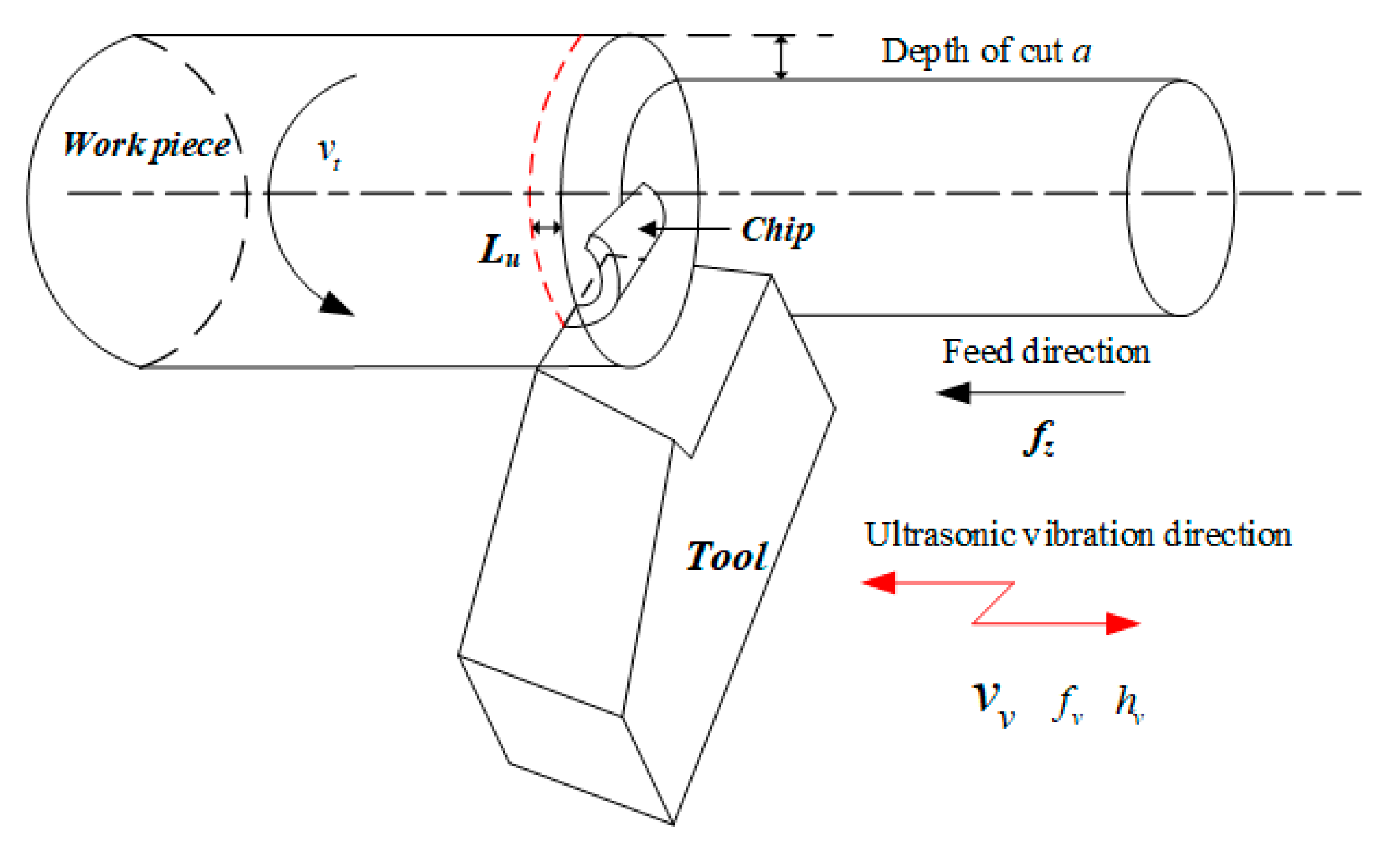

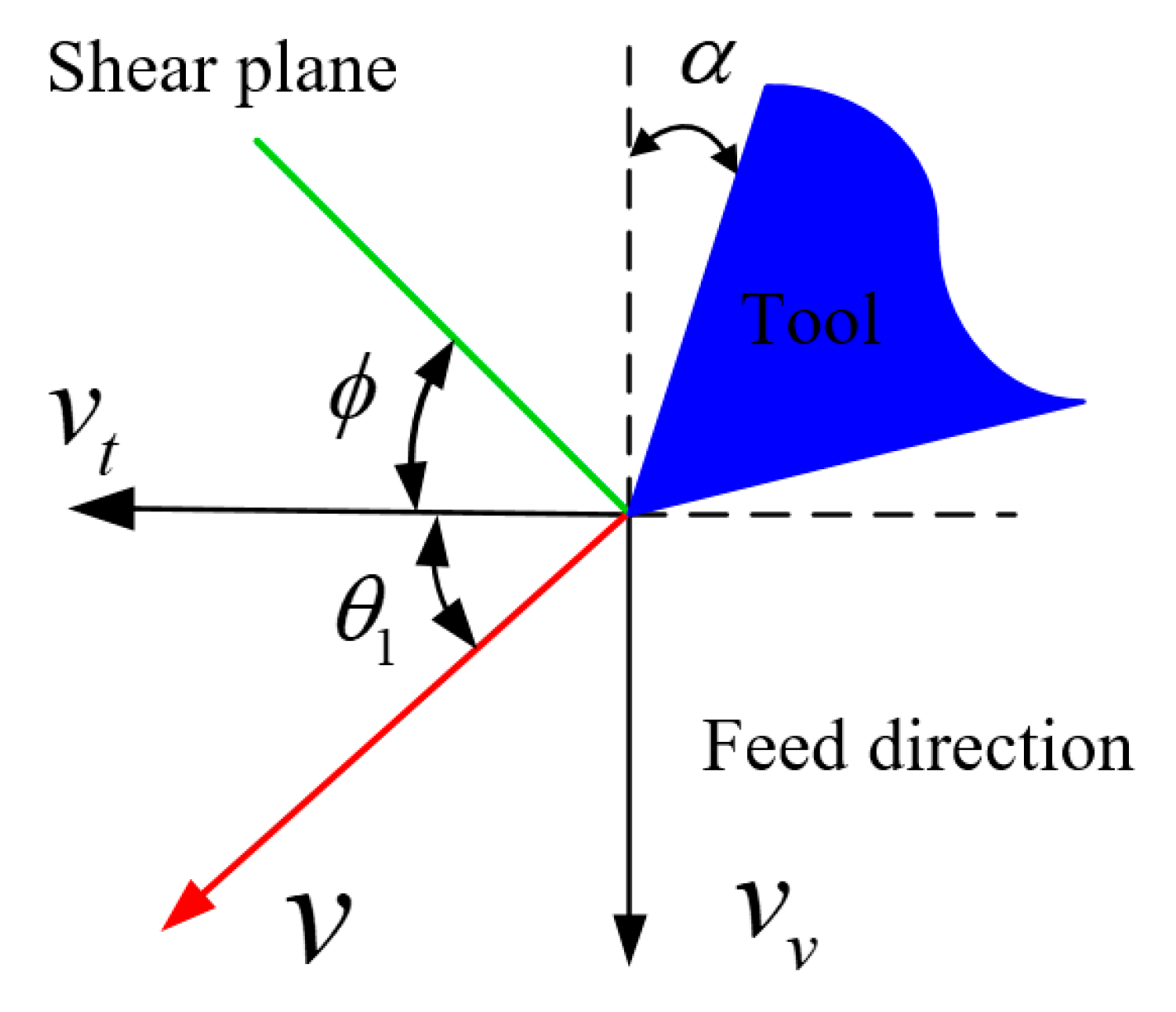

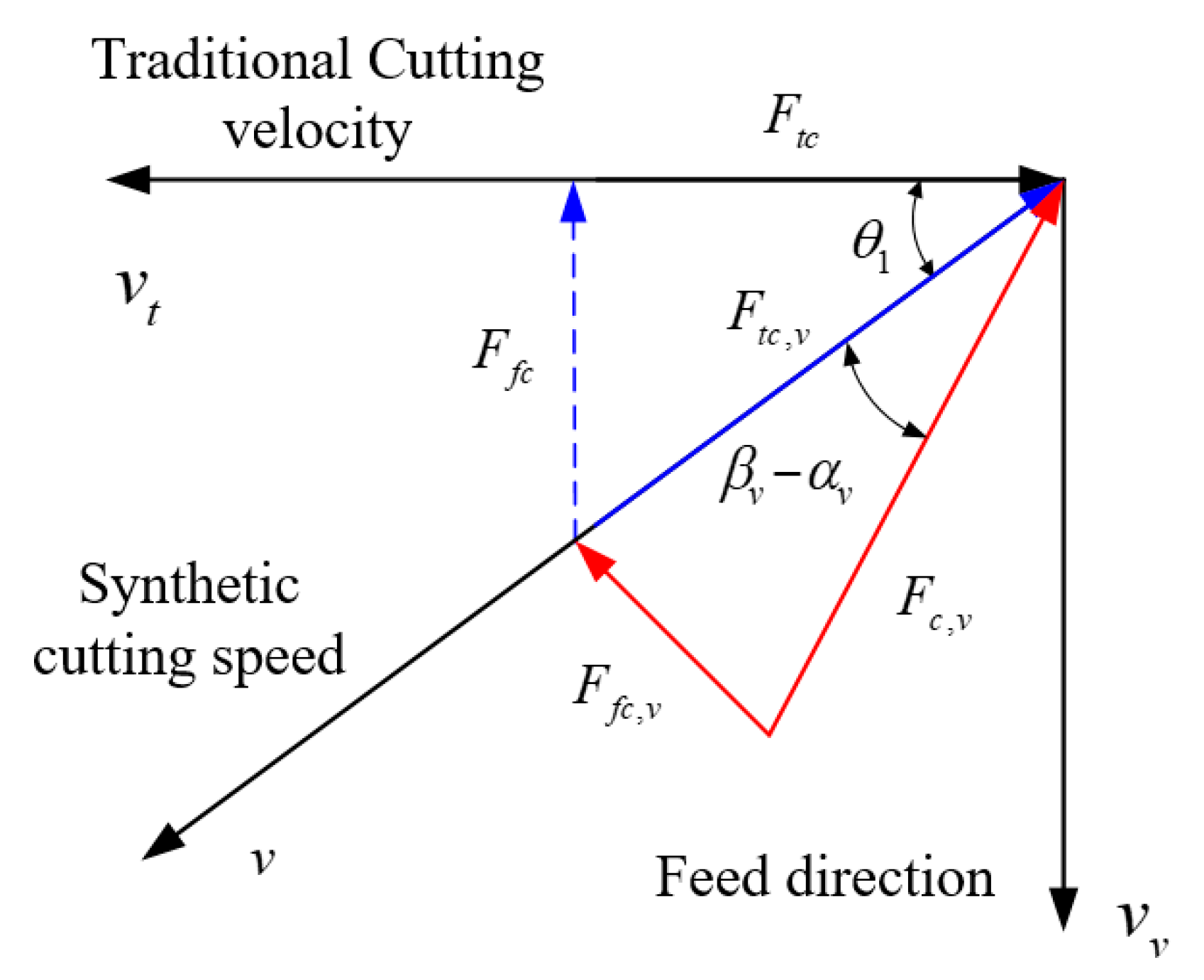

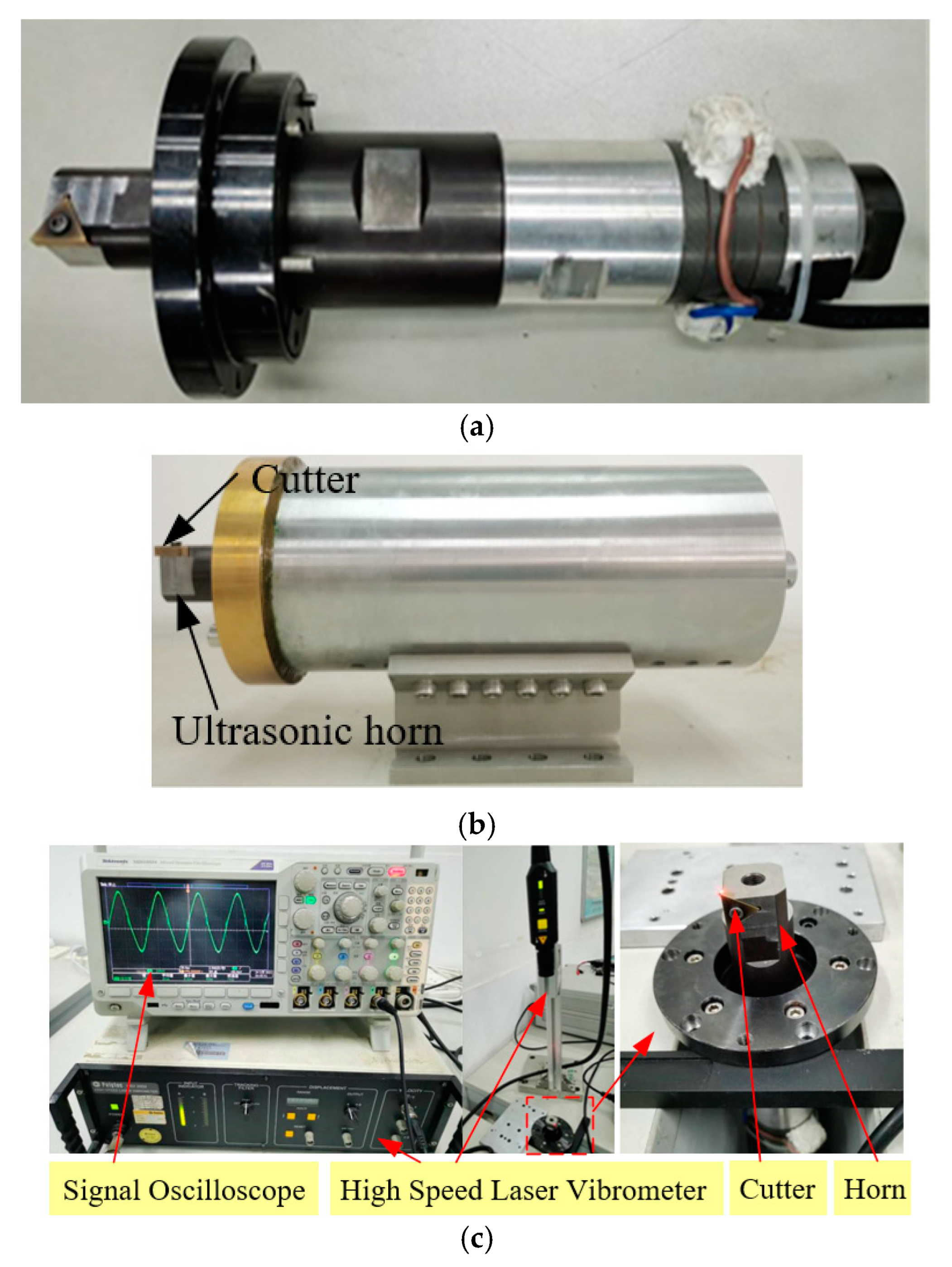
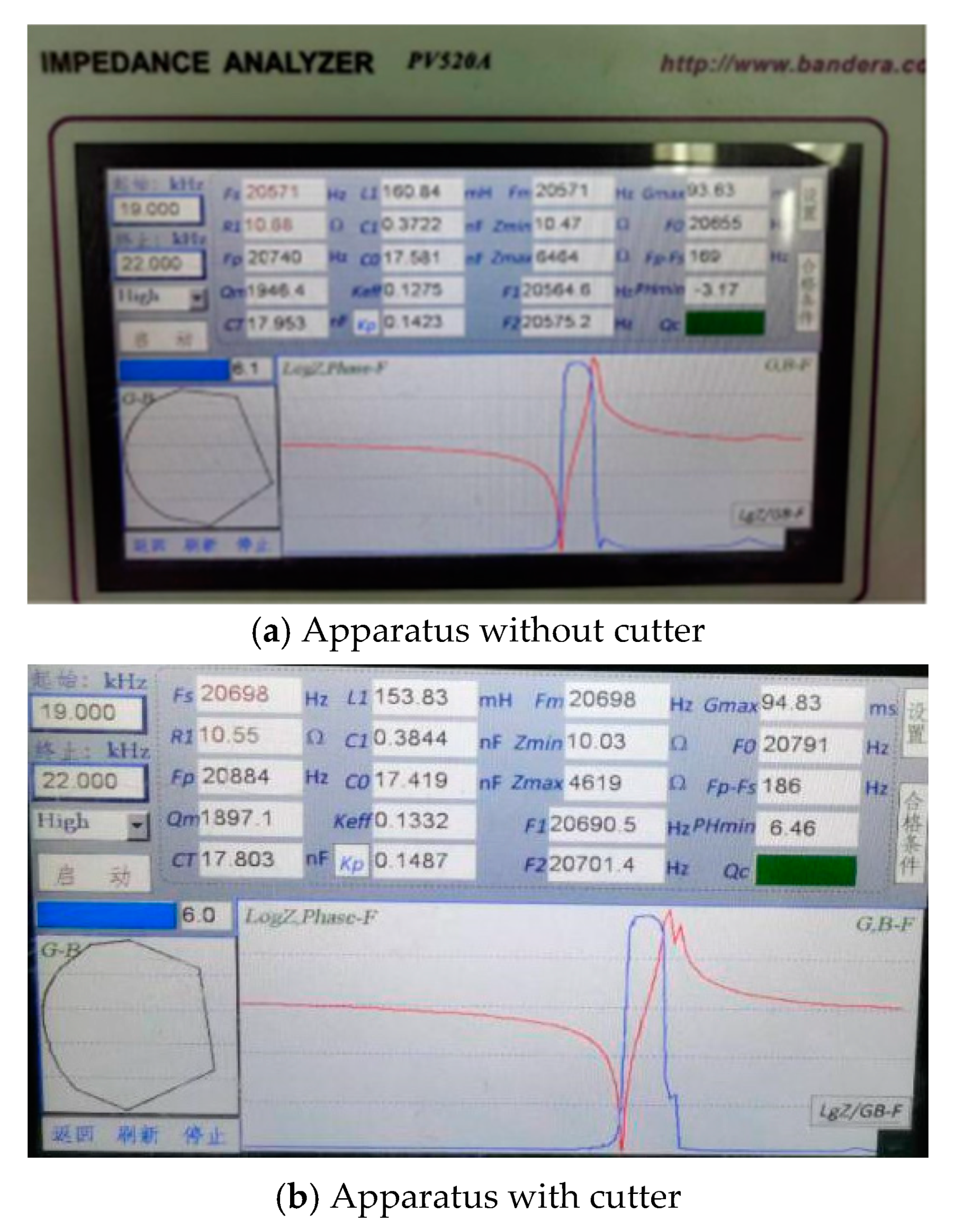
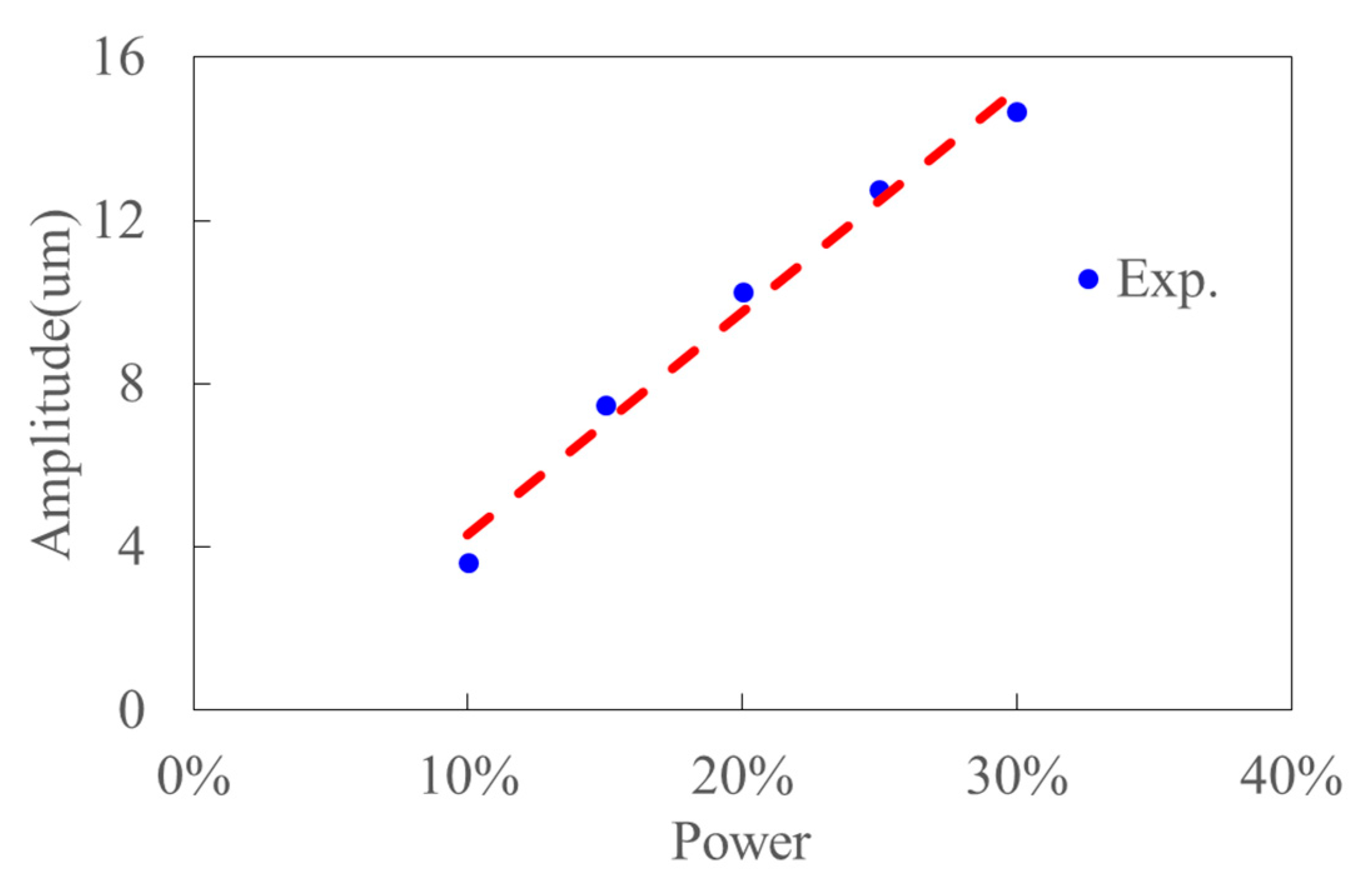
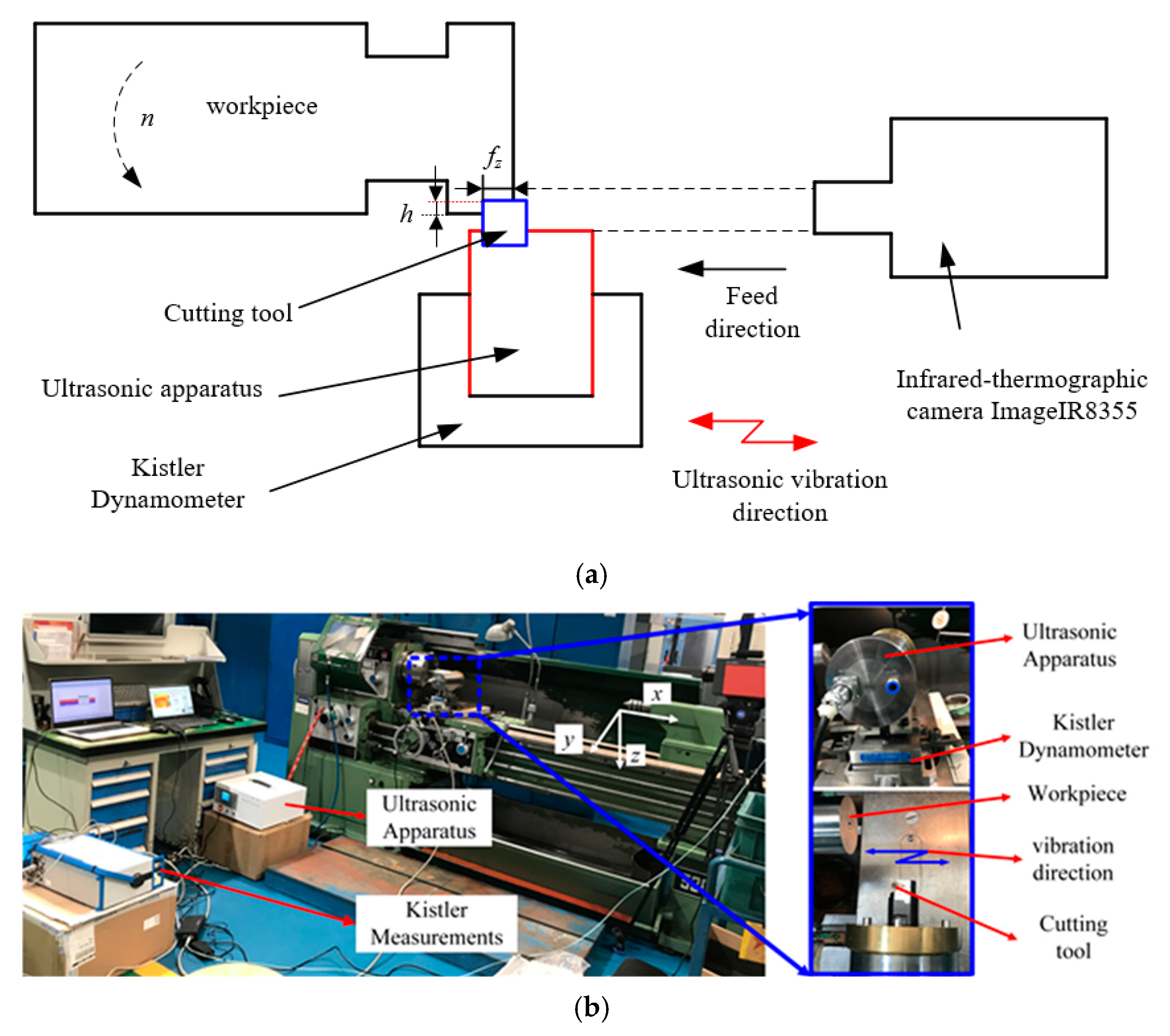

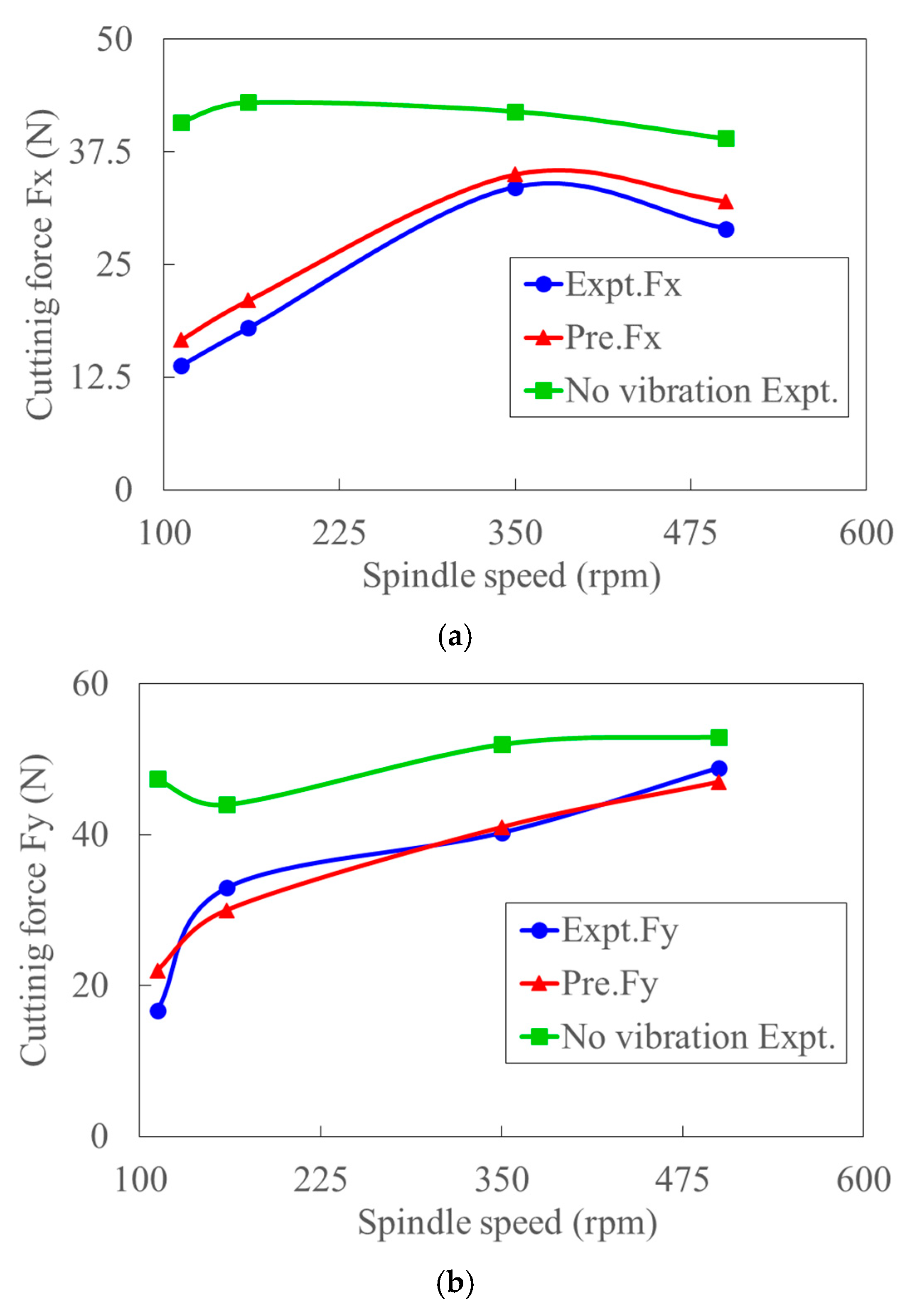
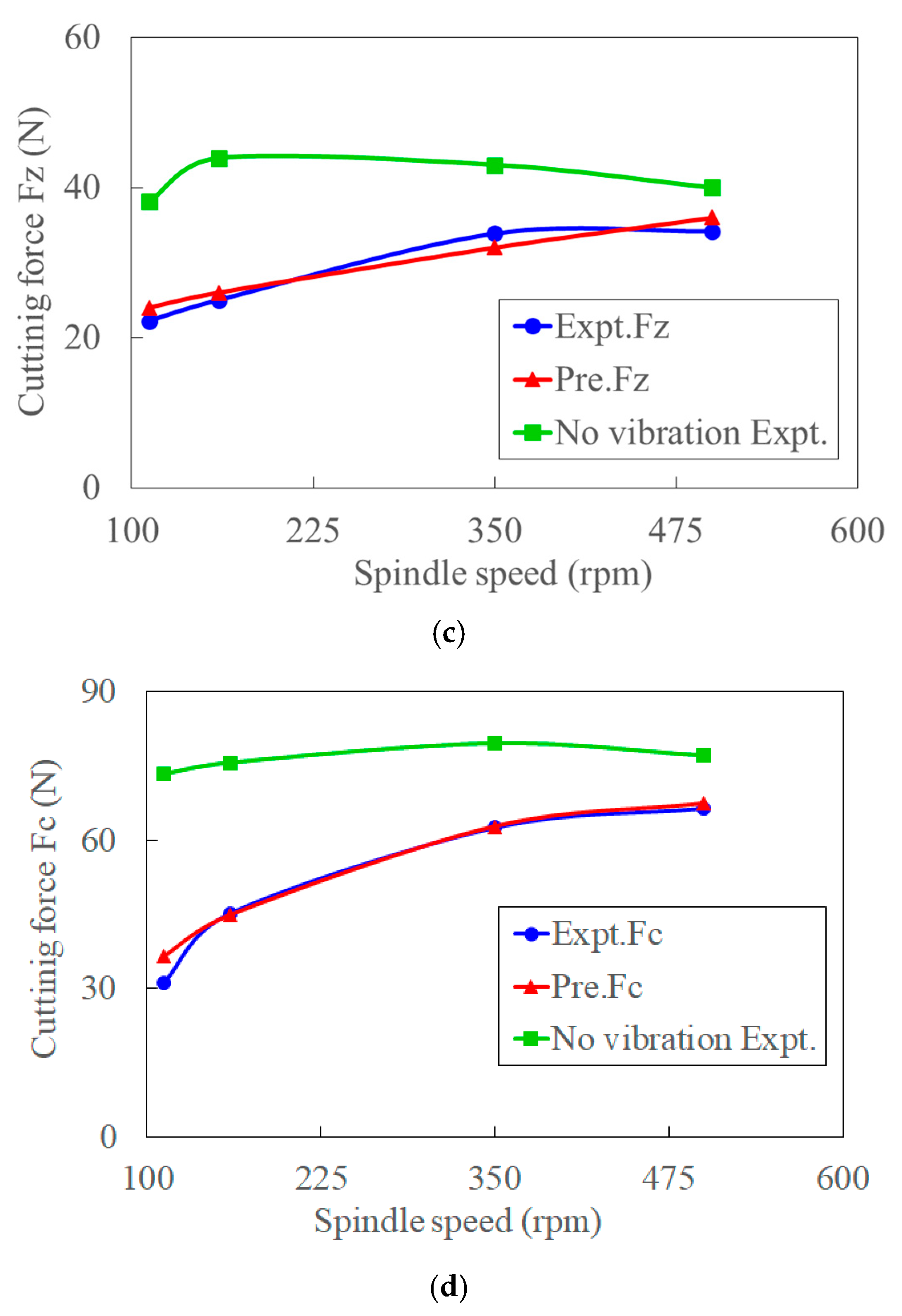
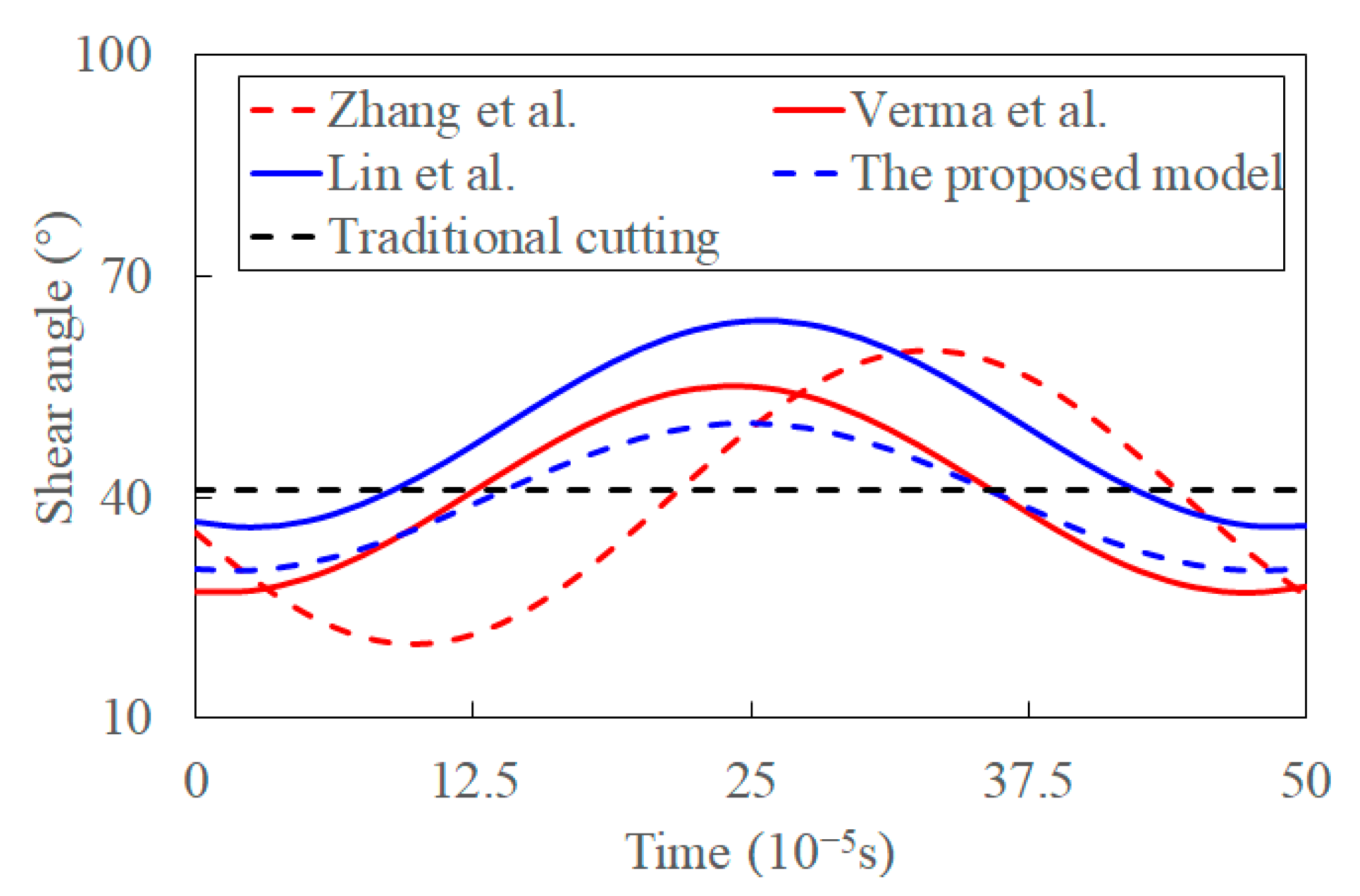

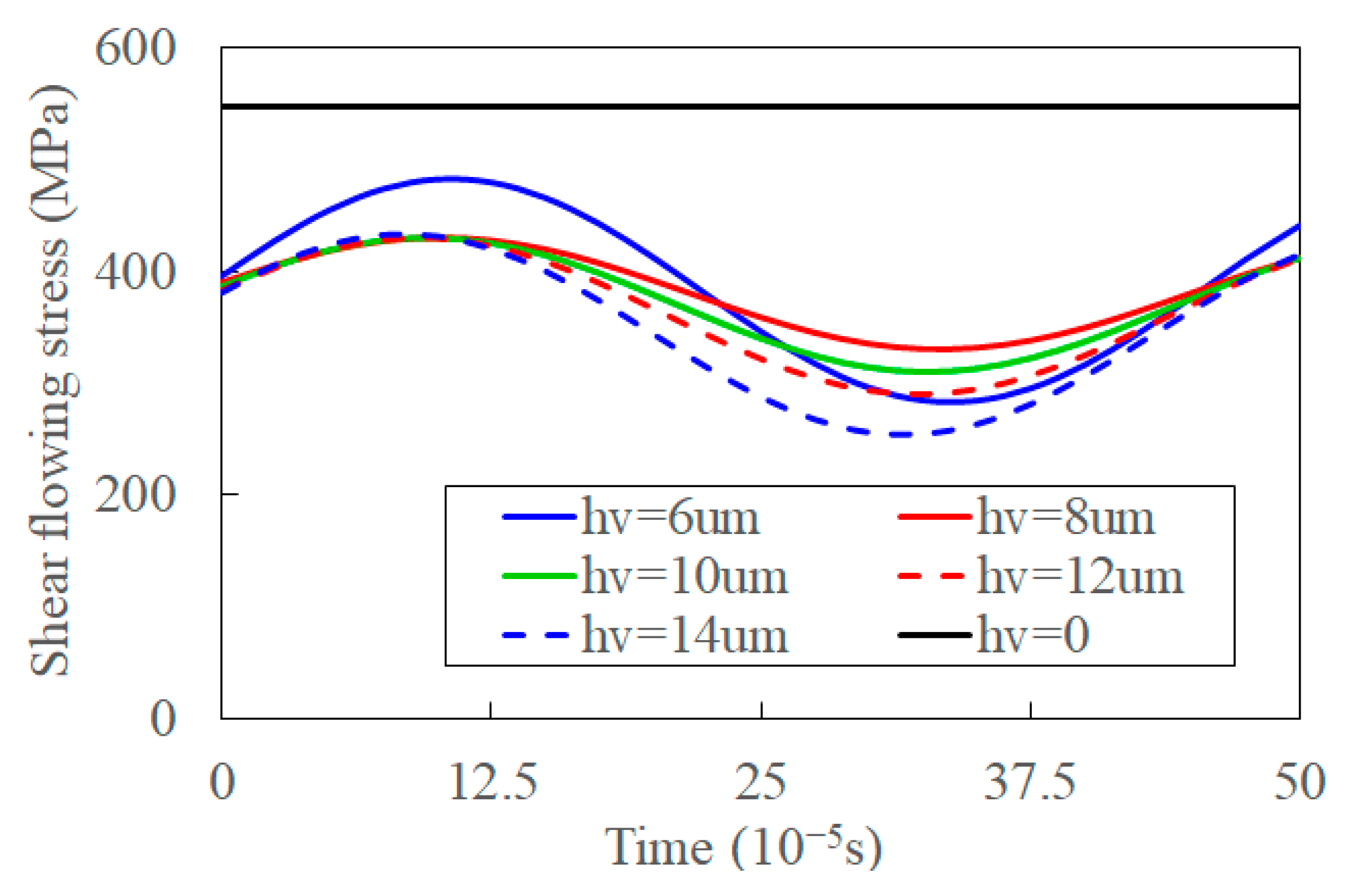

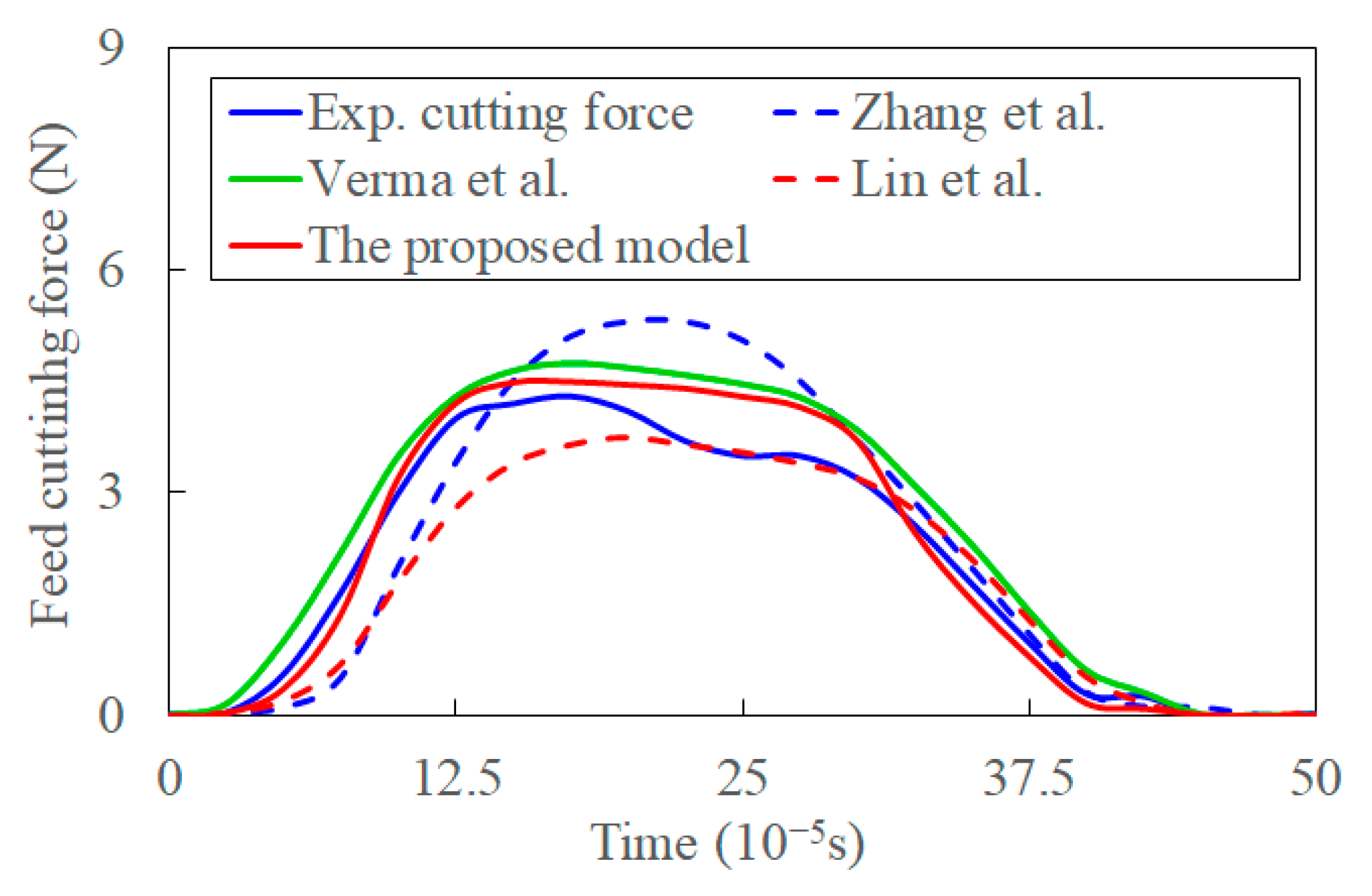

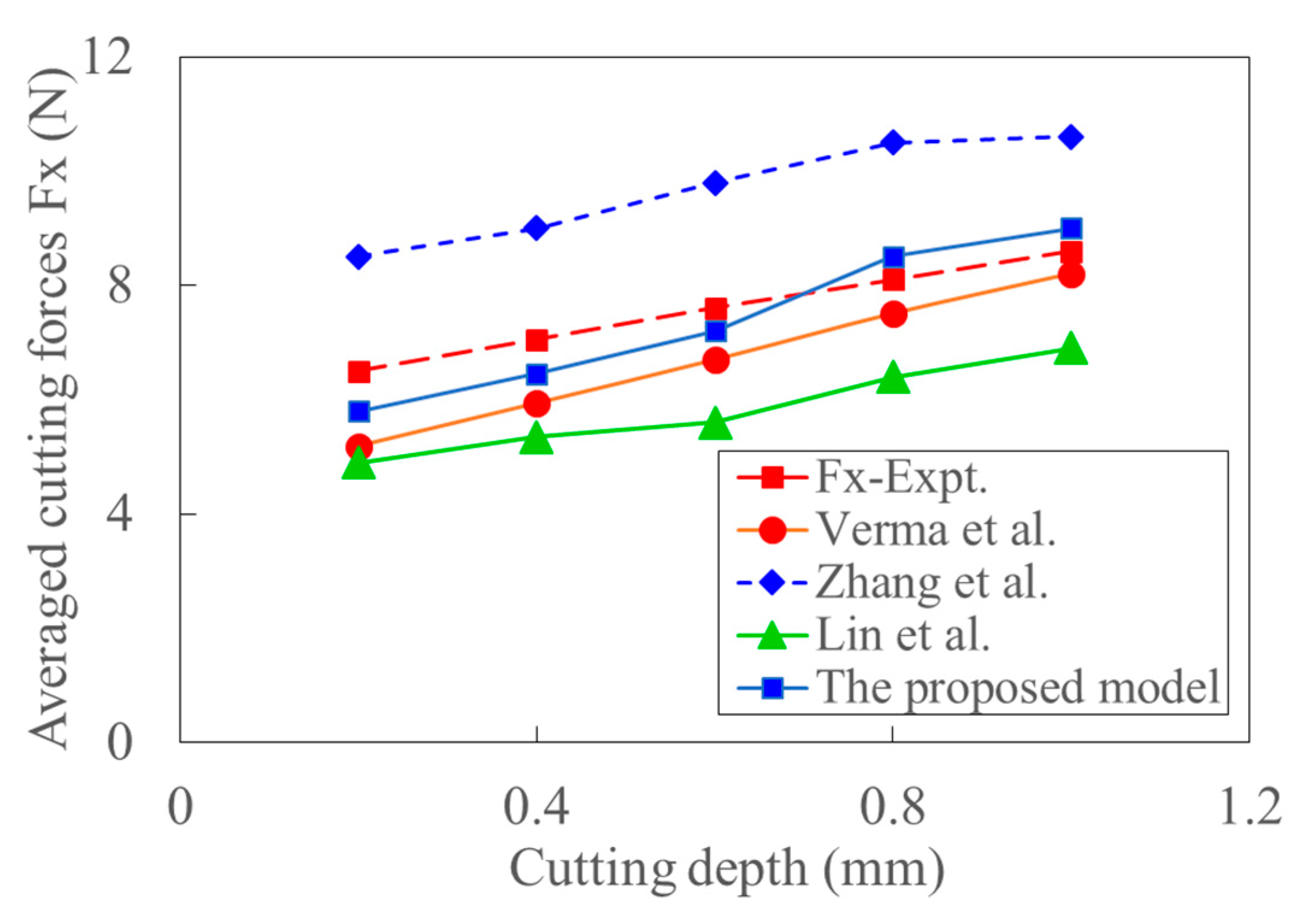
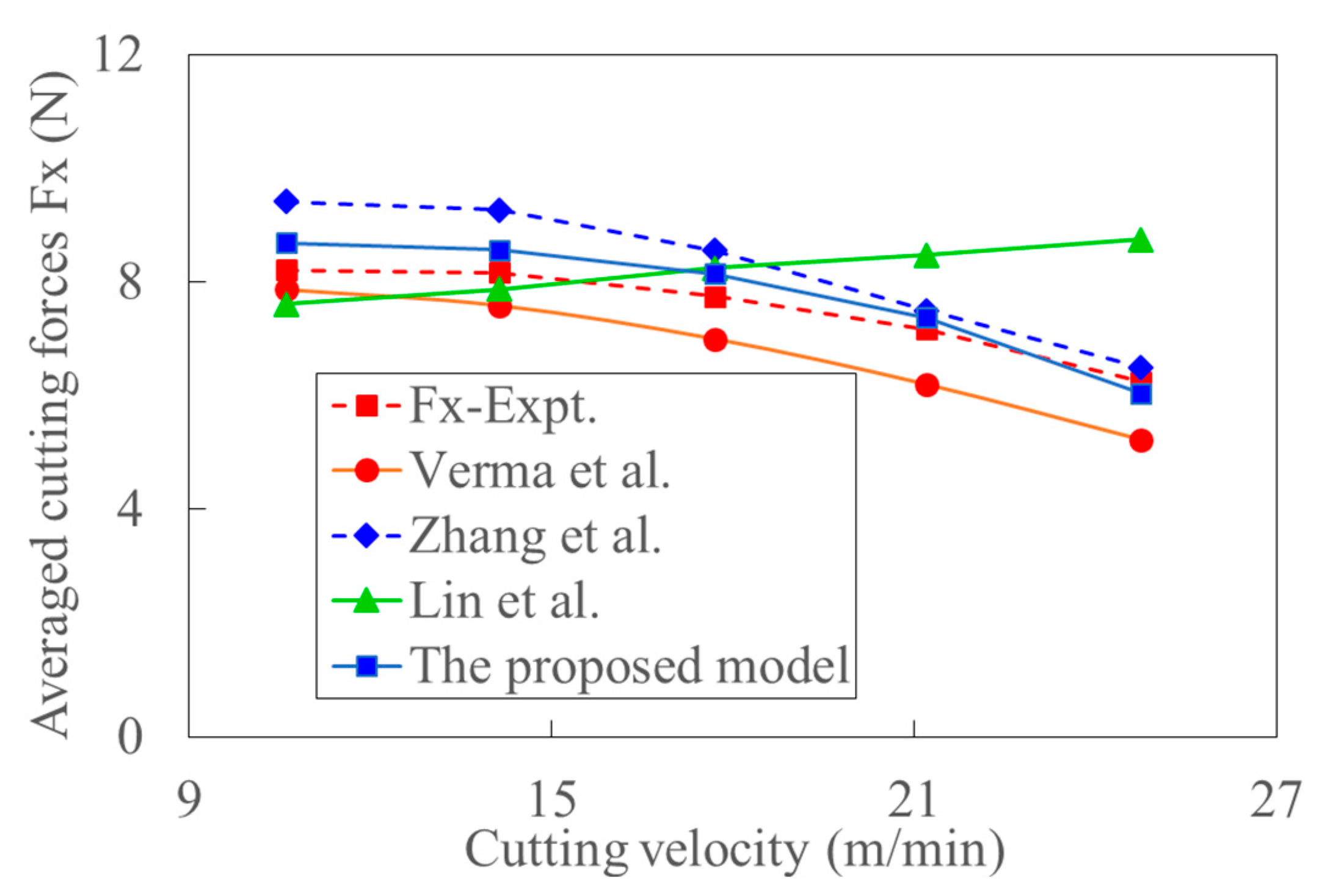
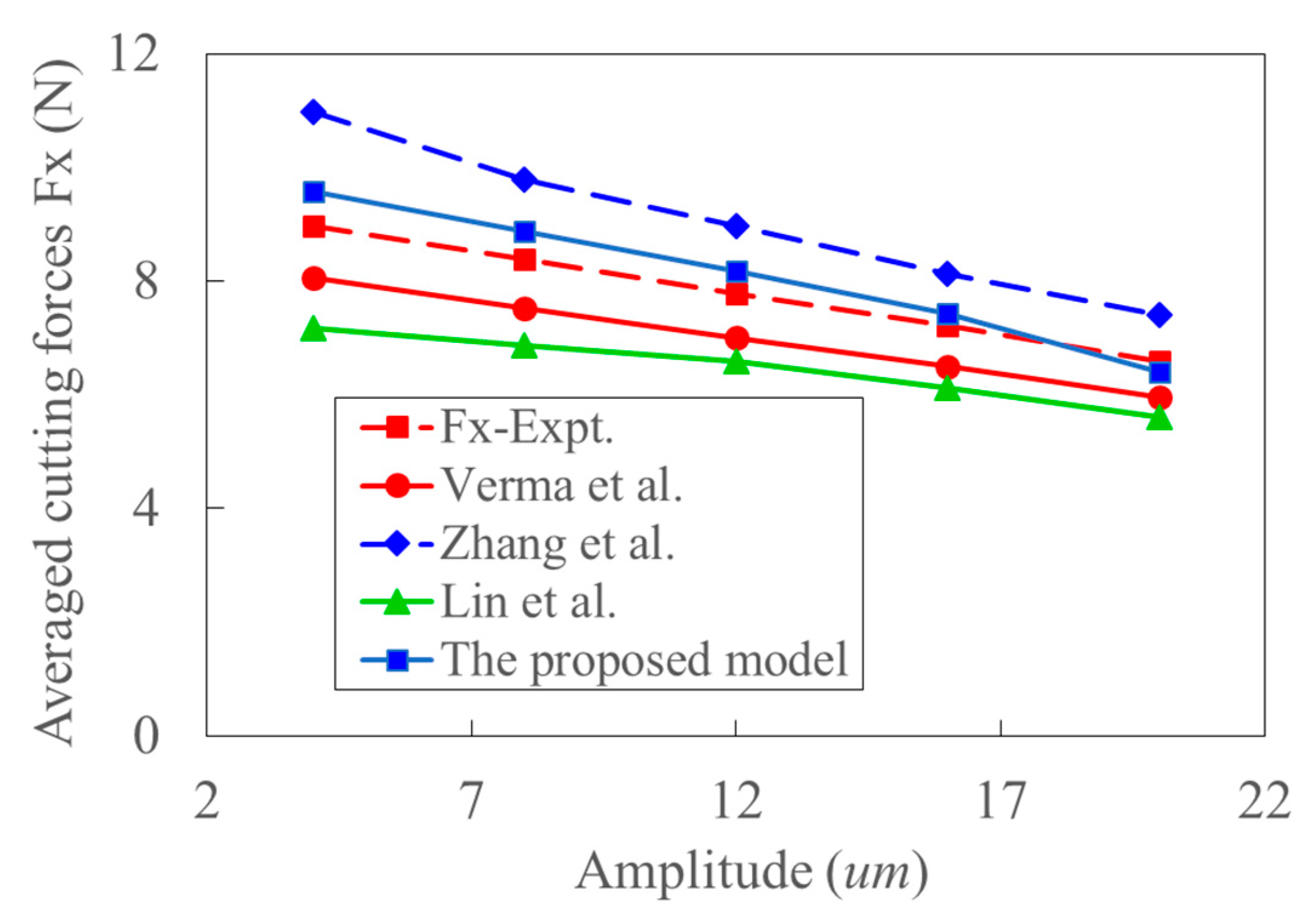
| Workpiece | Density (kg/m3) | Thermal Conductivity (W/m.K) | Specific Heat Capacity (J/Kg.k) | Thermal Diffusivity (m2/s) |
|---|---|---|---|---|
| Al 6063 | 2700 | 200 | 900 | 82 × 10−6 |
| Ti6Al4V | 4430 | 6.91 | 520 | 3 × 10−6 |
| AISI 1045 | 7860 | 48.3 | 473 | 13 × 10−6 |
| Apparatus with Cutter | Apparatus without Cutter | |
|---|---|---|
| Frequency (Hz) | 20,571 | 20,698 |
| Impedance (Ω) | 10.68 | 10.55 |
| Spindle Speed (rpm) | Cutting Velocity (m/min) | Cutting Depth (mm) | Feed Rate per Rotation fz (um) | Amplitude (um) |
|---|---|---|---|---|
| 112, 160, 350,500 | 41.5, 59.3, 129.7, 185.26 | 0.3 | 10 | 14.675 |
| Workpiece | A | B | m | n | c | Tm | |
|---|---|---|---|---|---|---|---|
| Al 6063 | 324 | 114 | 0.002 | 0.42 | 1.34 | 1 | 910 K |
| AISI 1045 | 553.1 | 600 | 0.0134 | 0.234 | 1 | 1 | 1733 K |
| Ti6Al4V | 783 | 497 | 0.028 | 0.28 | 1 | 1 × 10−5 | 1880 K |
| Element | Al K | Ti K | V K | Cu K | Fe K | Tatal |
|---|---|---|---|---|---|---|
| Weight% | 4.17 | 91.22 | 0.18 | 0.88 | −0.01 | 100.00 |
| Atomic% | 6.71 | 89.23 | 3.42 | 0.65 | 0.00 | – |
| Workpiece | Acoustic Softening Constant 1 | Acoustic Softening Constant 2 | Thermal Softening Coefficient | Fraction of Plastic Work Converted to Heat | Factor that the Work Done Outside the Thin Shear Zone | Taylor-Quinney Coefficient |
|---|---|---|---|---|---|---|
| Al 6063 [39] | 2.16 × 10−8 | 1 | 0.00166 | 0.9 | – | – |
| AISI 1045 | 3.03 × 10−9 | 1 | 0.001 [64] | – | 0.7 [60] | – |
| Ti6Al4V | – | – | – | – | – | 0.85 [60] |
Publisher’s Note: MDPI stays neutral with regard to jurisdictional claims in published maps and institutional affiliations. |
© 2022 by the authors. Licensee MDPI, Basel, Switzerland. This article is an open access article distributed under the terms and conditions of the Creative Commons Attribution (CC BY) license (https://creativecommons.org/licenses/by/4.0/).
Share and Cite
Chen, X.; Tang, J.; Shao, W.; Hu, B.; Ye, J. An Analytical and Experimental Study on Cutting Characteristics and Transient Cutting Force Modeling in Feed Directional Ultrasonic Vibration-Assisted Cutting of High Strength Alloys. Materials 2022, 15, 7388. https://doi.org/10.3390/ma15207388
Chen X, Tang J, Shao W, Hu B, Ye J. An Analytical and Experimental Study on Cutting Characteristics and Transient Cutting Force Modeling in Feed Directional Ultrasonic Vibration-Assisted Cutting of High Strength Alloys. Materials. 2022; 15(20):7388. https://doi.org/10.3390/ma15207388
Chicago/Turabian StyleChen, Xuelin, Jinyuan Tang, Wen Shao, Bo Hu, and Jinxiang Ye. 2022. "An Analytical and Experimental Study on Cutting Characteristics and Transient Cutting Force Modeling in Feed Directional Ultrasonic Vibration-Assisted Cutting of High Strength Alloys" Materials 15, no. 20: 7388. https://doi.org/10.3390/ma15207388
APA StyleChen, X., Tang, J., Shao, W., Hu, B., & Ye, J. (2022). An Analytical and Experimental Study on Cutting Characteristics and Transient Cutting Force Modeling in Feed Directional Ultrasonic Vibration-Assisted Cutting of High Strength Alloys. Materials, 15(20), 7388. https://doi.org/10.3390/ma15207388







